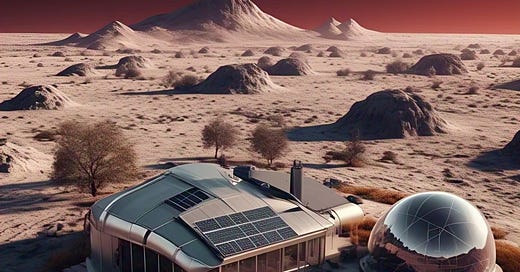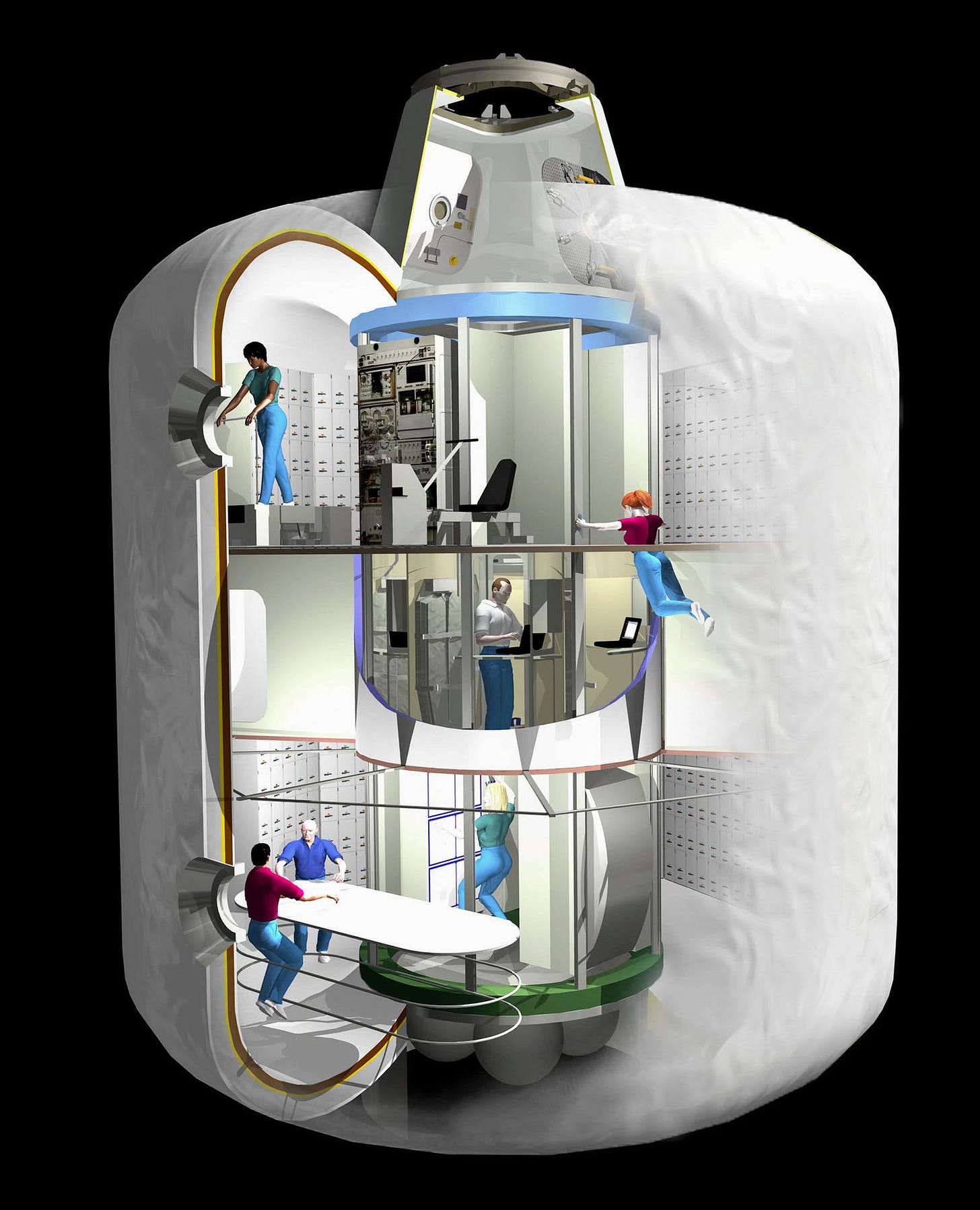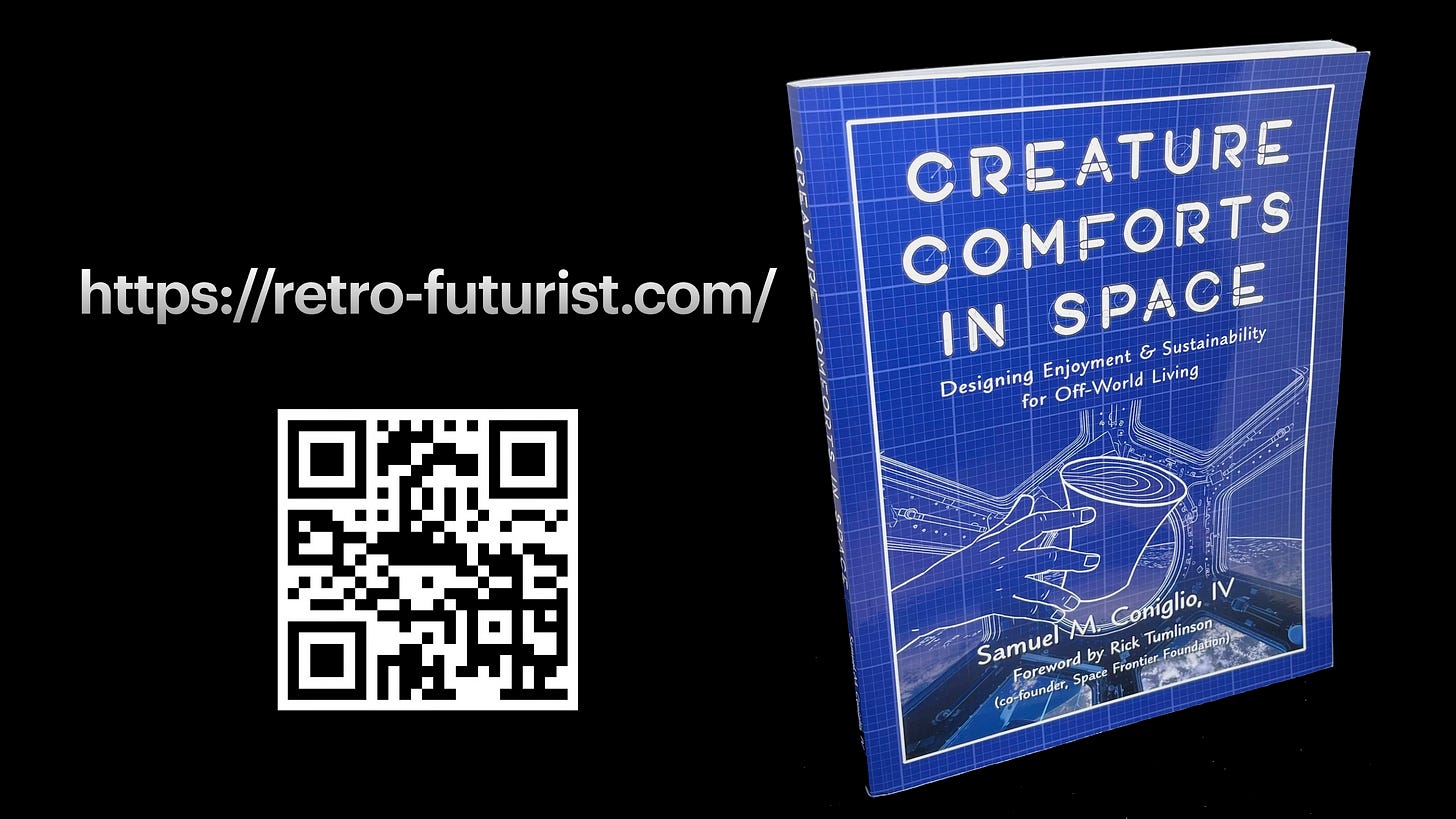Retro-Futurist #7: Basics of Living Off-World
Homesteads in the unknown
Throughout my book, “Creature Comforts in Space“ I use analogies to help better understand some of the complicated concepts related to life among the stars. One of them is the concept of homesteading. Popularly associated with the American Wild West, homesteading is about settling in new territory. It’s about building a farm and a ranch out in the wilderness, where you are on your own. You have to find water, and ways to raise plants and cattle. It is a rough environment. The weather is unpredictable. Yet, homesteaders who survived also thrived. Farms exist to this day that offer produce for people in their region and beyond.
By using this concept as a steppingstone to understanding how one can live on a space station in orbit or beyond, the reader can better understand the complexities and challenges one might encounter. In the beginning of the book I talk about all the things that could kill you, and then finding ways to mitigate that threat. Examples include pure vacuum, weightlessness, radiation, micrometeoroids, and many others. These are basically analogous to the harsh, unknown environment of the prairie, the desert, the mountains, or the Arctic. The difference, of course is that outer space is a new and unique environment for us. Humans have never been there for long periods of time before. This is changing with the advent of space stations.
The International Space Station (ISS) is the longest running space station program in the existence. Since the early 2000s, the ISS has offered not only shelter, but also a place to explore and learn about this new environment with science. Humans now know a lot more about living in off-world than ever before. It is time to take those lessons learned and focus on other areas that can improve human comfort such those mentioned in my book.
Home is where the heart is
Think about your own home. In your kitchen you have a stove, a refrigerator, and a sink. Those three items are part of what architects call the “kitchen triangle.” Those three areas are continuously interacted with whenever you are making breakfast, lunch, or dinner. One place is for storing the food, one place for cooking and making the food, and another place to clean the dishes after you’re done. (I guess I could also add the dishwasher as well.) We are spoiled by our modern conveniences. We just take it for granted that the refrigerator is going to work, that the stove will have power, and the food will not spoil.
Gimme shelter
There was an amazing publishing house called Shelter Publications.* Founded by Lloyd Kahn in the early 1970’s, Shelter Publications specialized in large picture books on DIY home building. It was a showcase of human ingenuity. The homes that were showcased were built by regular folks, not certified architects. The reader was presented with works of other cultures and countries, as well as stuff that hippies and self-styled carpenters made in the United States in Canada. In later years, the publisher became a leader in the “tiny home” movement. Some adventurous folks started thinking about how to build small and learn to live with less. The creativity in building such a small home was quite amazing. Using found materials or leftovers from other construction sites, these imaginative builders invented their way into a new lifestyle. Later books focused on “rolling homes.” Related to the VanLife movement that is all the rage right now, the books showcase mobile living at its most energetic. People learned how to make do with far less than ever, and yet they’re able to see the world and enjoy life better.
*Note: As of May 2024 Shelter Publications books are now being sold by AdventureKeen Publishers. The ShelterPub blog is still active. Also, Lloyd Kahn’s personal blog is now on Substack!
What does this have to do with outer space? Well, it was inspiration for me to think out of the box. For decades, we were used to the lumbering bureaucratic process used by NASA to design and develop spacecraft and space stations. In my years of research, I noticed a disturbing trend where politics overruled design. People were taking less chances. Innovation became extremely incremental. Space station and rocket designs seemed to predicate upon the political expediencies of the moment.
Case in point: There was a design concept in 1997 called TransHab. It was a fully inflatable space habitat. Using a flexible Kevlar outer shell, which is a bulletproof material, the structure could fit small and neatly inside the payload bay of the space shuttle, then it could be expanded into a very spacious living area. It would be one of several modules launched into orbit and assembled tinker toy style into a space station.
Though this concept was rather innovative, it was shelved by NASA. In 2000, A business man named Robert Bigelow from Las Vegas, licensed the technology from NASA and started a company called Bigelow Aerospace. The idea was to build real estate in orbit! Two prototypes were built and flown, in 2006 and 2007. They are still in orbit today. They were pressurized and held their weight without a problem. Several full scale mock ups of the Bigelow space stations were developed on the ground, waiting for a customer. For nearly 20 years, they developed and tested their technology and even built a small habitat for the ISS.
Unfortunately, Bigelow was ahead of his time. His company built a viable space station concept, but unfortunately, early to mid 2010s there was no transportation system to get there. NASA was only interested in building and maintaining the ISS, and there were no alternative people-carrying vehicles beside the US space shuttle and the Russian rockets. It was like building a hotel before cars were invented.
So in 2020, in the middle of the pandemic, Bigelow Aerospace folded, ironically just as the long-awaited transportation system was just becoming available. SpaceX had just perfected the Falcon 9 rocket, and the Dragon crew capsule was starting to carry astronauts.
Orbital Business Park
Since 2021, about eight companies have emerged with proposed space station designs. NASA, realizing that the ISS was reaching the end of its lifetime, created a Commercial Low Earth Orbit Destination (CLD) Program to support the development of one or more replacement space stations.
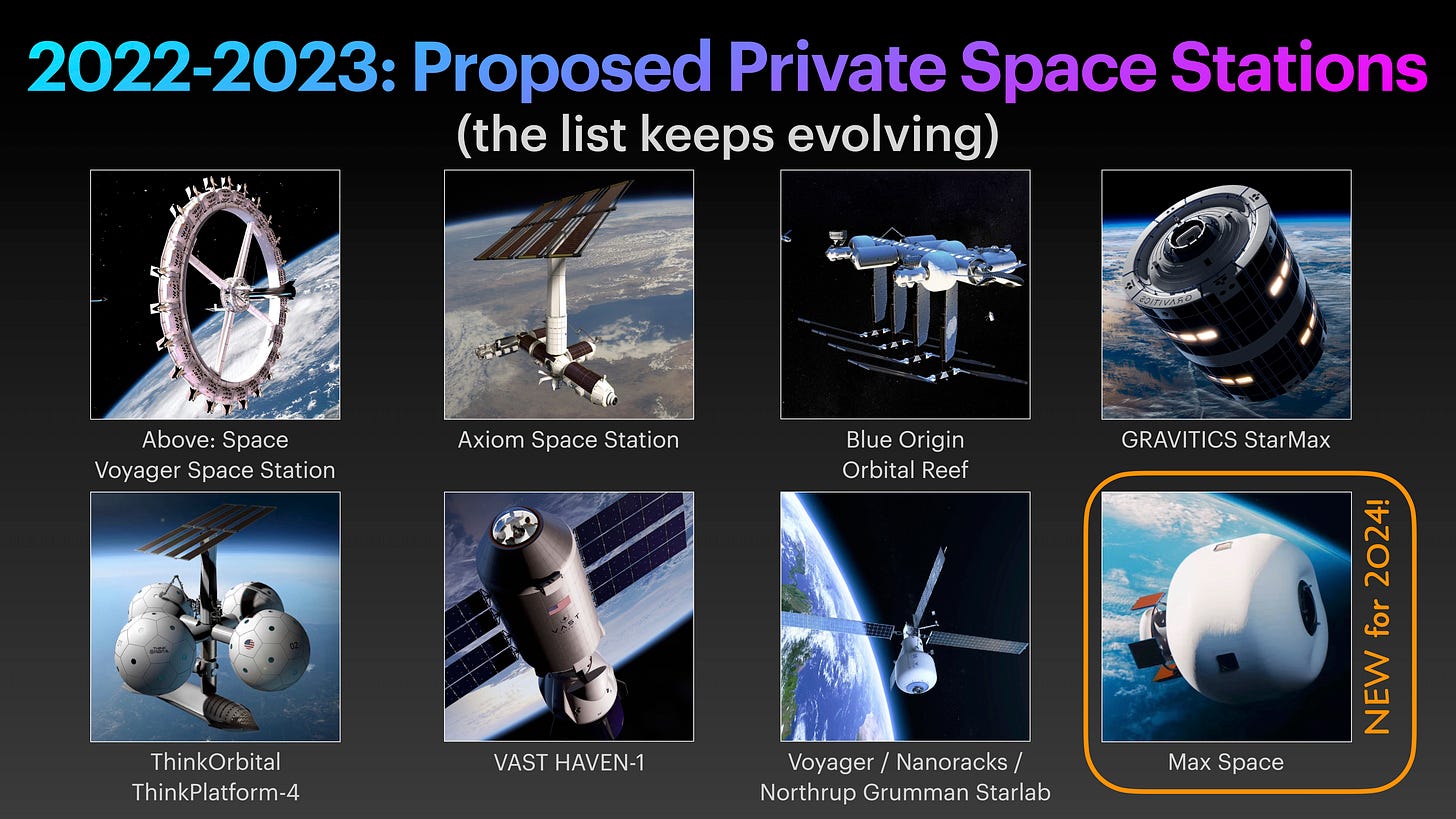
The dream for many Space Advocates is to have a collection of space habitats in various orbits around the Earth and the Moon and beyond so that we can build a proper orbital infrastructure for continuous sustainable human life off-world.
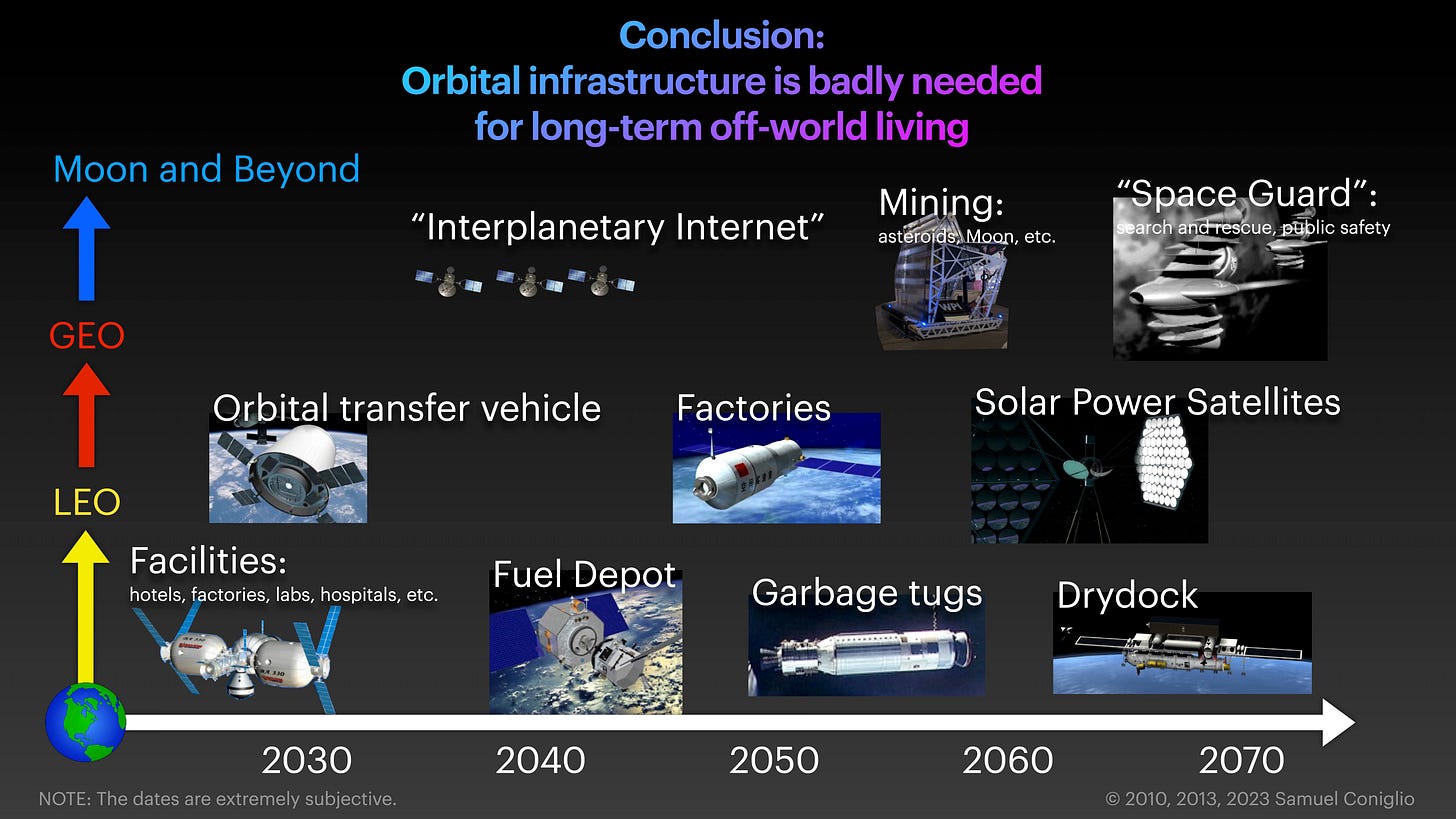
Many space station proposals have come and gone over the decades, but this time there is a critical mass of companies with real investment capital, and are cutting metal and assembling prototypes or building for first flight. Combined with NASA’s support, one or more of these companies are going to succeed. Some are going to fly in 2025. These new facilities are going to be multipurpose. They will be available to do science engineering work plus they will be the first space hotels. Yes you heard me right. Finally, proper accommodations for those jet setters who would like to go someplace different.
It all comes down to design
When designers and engineers work together, magic happens. Artistic creativity, combined with technical know how to create beautiful space habitats that could look like cruise ships or hotels or something more exotic. By allowing such creativity, we finally allow humans to be human off the planet. For 50 years, we have been in a Catch-22 situation: many people wanted to go into space, but there was no reliable rockets or infrastructure for them to go, and no investors wanted to take chances building off-world infrastructure because there was no one out there. We are finally now bridging that gap. With the advent of the SpaceX Starship, we are on the verge of building truck stops, hotels, and gas stations in orbit. Eventually, we will have office parks and research centers and entertainment spaces as well. Basically you’re creating cities and communities off our planet and expanding into a new territory.
Like the unusual homes built and showcased in Shelter Publications books, these new off-world habitats will be very creative and unusual. They have to be: the human race has never permanently settled a frontier like this.
2025 Upcoming Events
My goal is to make 2025 the year of the San Francisco Bay Area Book Tour! I’m making the phone calls and emailing the science museums and various book stores. As soon as things get more solid, I will make some announcements. If you have any suggestions where I should do presentations and/or sell my book, please send me a line at contact@retro-futurist.com.
About the Book: “Creature Comforts in Space”
This is a popular science book about the challenges of living in space and using them as design constraints for better off-world living.
ISBN & PRICE
Paperback: 979-8-218-24640-2 | $33.00
Ebook: 979-8-218-24639-6 | $9.99
*Don’t forget to write a review! Thanks!

